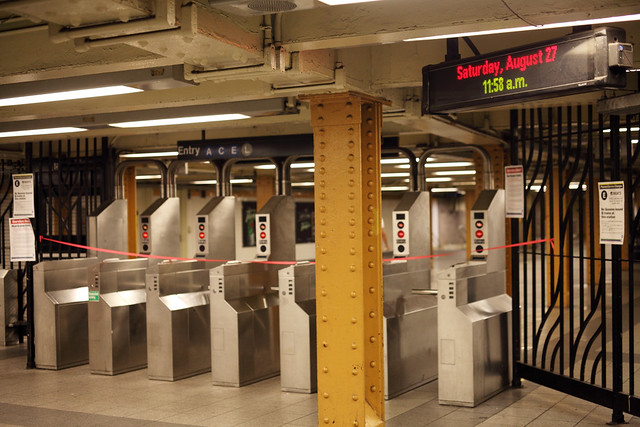When state officials in Albany announced a budget deal that saved the MTA’s dollars, not all transit advocates rushed to take the bucks with open hands. Although the money will allow the MTA to secure federal transit dollars while finishing Phase 1 of the Second Ave. Subway and the work at Fulton St., among other projects, the structure of the budgetary grant will also lead to more MTA debt, and as those debt figures climb, many are growing wary.
Transportation Alternatives has taken a lead role in warning about the MTA’s looming debt crisis. For the foreseeable future, the authority will devote a significant amount of resources toward debt payments, and as those payments come out of the agency’s operating budget, riders who shoulder a significant portion of that budget through fares, will be paying for debt. Ostensibly, that’s not a good thing for riders.
“This deal is an express train to more MTA debt, higher MetroCard fares and less subway and bus service,” TransAlt’s Executive Director Paul Steely White said last week. “When it comes to public transit, Albany only knows two plays: paying for it with more debt or robbing riders of hundreds of millions of dollars in dedicated transit funding. Both put the 7.5 million New Yorkers who rely on the bus and subway on the fast track to higher fares and more service cuts. Today’s plan doubles down on the State’s dangerous commitment to funding transit through debt. Governor Cuomo and the State Legislature must invest in transit through secure and sustainable sources of revenue.”
Advocates aren’t the only ones sounding the alarm though. As Streetsblog reported yesterday, Senator Gustavo Rivera from the 33rd District in the Bronx bemoaned the state’s actions as well. In calling for new sources of MTA funding, Rivera let it rip: “The great majority of people in my district rely on mass transit every single day. And when we look at what’s happened in the last couple of years, where the state has at different times raided the MTA and taken hundreds of millions of dollars that is supposedly dedicated transit funding, and instead uses it for all sorts of other things, what this has led to, as we know, is that the MTA has gone into a spiraling hole of debt.”
Now, I’m thrilled to see Rivera embrace transit. His predecessor Pedro Espada, Jr. clearly did not. But at the same time, the incessant focus on debt is obscuring some more serious issues. It’s true that the state has taken $260 million in dedicated transit funding away from the MTA over three years, but it’s also true that $86 million a year is barely 1 percent of the MTA’s overall operating budget. Since the MTA operates on razor thin margins, the impact of the reappropriation is magnified, and it should not be excused. It’s not however the only problem.
Meanwhile, for all the talk of alternative revenue streams — congestion pricing, bridge tolls, residential parking passes — the endgoal will not be a fully funded MTA capital plan. Rather, the end goal is to raise enough money to alleviate the pressures on the MTA’s operating budget while providing the agency with a steady revenue stream against which it can bond out more projects. This is the classic model of government spending. Ideally, the MTA would borrow money today to build a revenue-generating project tomorrow, and it would then pay off the bonds with increased fare revenue. That’s what’s happening along Second Ave.
The problem is that the MTA is spending exorbitant amounts of money on State of Good Repair work that has a negligible impact on ridership and costs far more to complete than it can realize through increase ridership and fare revenue. After decades of deferred maintenance, the authority is playing catch-up, and we the riding public are left saddled with the debt.
We shouldn’t excuse Albany for its failures, and we should applaud Gustavo Rivera for raising his voice. But we must recognize that Albany will not simply hand over $4-$5 billion a year for the MTA to invest in capital projects. One way or another, debt will remain in the picture. How the MTA picks what projects to fund through debt-producing bonds though will determine the future of our subway system.

 Last week, straphangers at a random smattering of subway stations scattered throughout the city found themselves with a free ride. On Wednesday morning, protestors from Occupy Wall Street allegedly in conjunction with some TWU rank-and-file members posted faux-service advisory signs in certain stations and propped open emergency exits so that subway riders could enter the system for free. Five days later, authorities are investigating, and TWU higher-ups are disavowing any ties to this stunt.
Last week, straphangers at a random smattering of subway stations scattered throughout the city found themselves with a free ride. On Wednesday morning, protestors from Occupy Wall Street allegedly in conjunction with some TWU rank-and-file members posted faux-service advisory signs in certain stations and propped open emergency exits so that subway riders could enter the system for free. Five days later, authorities are investigating, and TWU higher-ups are disavowing any ties to this stunt.













 (42nd Street Shuttle)
(42nd Street Shuttle)



